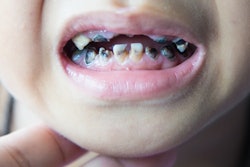
More than 12 million children experienced untreated coronal caries between 2011 and 2014, even in the era of the Patient Protection and Affordable Care Act (ACA). The statistic comes from a new study that looked at demographic and socioeconomic factors associated with untreated decay.
Financial and nonfinancial barriers both influenced the likelihood that a child would experience untreated caries, according to the authors. The researchers published their findings in BMC Oral Health (March 6, 2018).
"Demographic factors such as age, socioeconomic factors such as family income level, access to care, and utilization of care were significantly associated with untreated caries among children," wrote the authors, led by Niodita Gupta, MD, MPH, PhD, a researcher with the ADA Health Policy Institute.
Disparities in dental care
In 2010, the ACA established children's dental care as an essential health benefit. The researchers, therefore, wanted to study how the ACA mandate affected the rate of untreated caries in children.
To find out, they used data from the National Health and Nutrition Examination Surveys from 2011 to 2014. The surveys are conducted by the U.S. Centers for Disease Control and Prevention's National Center for Health Statistics and are designed to provide nationally representative data about the health status of children and adults in the U.S.
More than 12 million children had untreated coronal caries between 2011 and 2014, the researchers found. Family income level, financial and nonfinancial barriers, and dental visits were all significantly associated with the likelihood of a child experiencing untreated decay.
"It is possible that nonfinancial barriers such as lack of convenient appointment times, parental busyness, prohibitive distance to dentist's office, or a child's fear of the dentist play a critical role in untreated caries among children and deserve more attention," the authors wrote. "Interventions such as school-based sealant programs may help address nonfinancial barriers by bringing the dentist to children and eliminating travel and time-related barriers."
See more findings from the infographic below.
 Hidden epidemic: A new look at untreated decay in kids
Hidden epidemic: A new look at untreated decay in kids


















